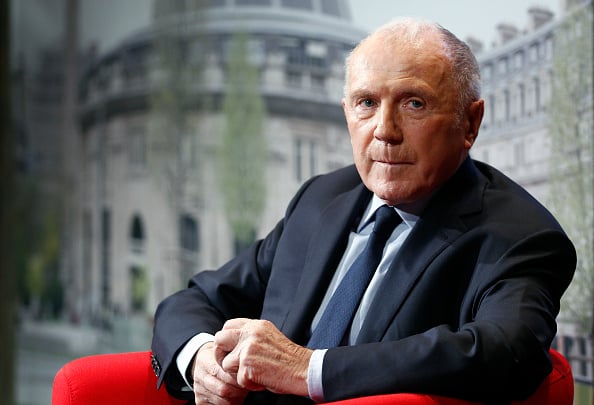Art World
Did Paris Overpay $103 Million for the Building That Will House François Pinault’s Art?
The Pinault Collection reveals the cost of the French billionaire's planned private museum as the Mayor of Paris comes under fire.

The Pinault Collection reveals the cost of the French billionaire's planned private museum as the Mayor of Paris comes under fire.

Hili Perlson

Did Paris overpay millions of euros for the building that will be the home of François Pinault’s planned museum in the French capital? Recent articles in the French media claim that the city shelled out an inflated amount for the historic Bourse de Commerce near the Centre Pompidou, when it was bought in 2016. Last week, the French satirical weekly Le Canard enchaîné published a story claiming that the city of Paris had bought the site slated to become a museum housing François Pinault’s contemporary art collection for more than $103 million when it could have been acquired for one Franc (around 15 cents).
Pinault, the mega-collector and billionaire owner of Christie’s, subsequently signed a 50-year lease on the site, and is footing the bill for the renovation of the former stock exchange building. The Pinault Collection will also be responsible for all future running costs of the private museum.
As well as overpaying for the site, Canard accused the Mayor of Paris Anne Hidalgo of “mismanagement,” claiming that the city should have enforced a clause which would have allowed it to buy the building for a few cents. How did the weekly come up with that? In 1949, the article explains, the Chamber of Commerce and Industry (ICC) bought the building from the city for the symbolic amount of one Franc. Back then, “a special condition was added to the contract,” the weekly points out, which stipulates that the transaction can be annulled if the building is no longer used for its original purpose of “public services dependent on the Chamber of Commerce,” thus allowing the city to buy it back for the sale price from nearly 70 years ago.
The Pinault Collection tells artnet News that it was not involved with the building’s purchase. In a statement, it says:
The Pinault Collection was not party to the negotiations between Paris’s Chamber of Commerce and Industry and the City of Paris. That being said, the City of Paris has subsequently given in this regard clear and detailed public explanations in particular during its deliberations of 4, 5 and 6 July, 2016. The Pinault Collection became acquainted with those at their public release.
In light of the media frenzy that the Canard article has sparked, Paris’s City Hall rejected the publication’s claim, saying that Canard’s interpretation of the 1949 contract is wrong, reports AFP. The lease prohibited the Chamber of Commerce from selling the building to third parties, it stated, but in the case of a resale to the City of Paris, “the ICC was entitled to the value of the property.”
“There was some negotiation on the price, but it is wrong to say that Paris could have bought it at the same price as in 1949,” a spokesperson for the Mayor has said. City Hall also added that the acquisition and the price tag have been approved by the French Heritage Council.
In the statement sent to artnet News, the Pinault Collection laid out the projected cost for the museum, which is due to open in 2019:
The financing of the Museum, both for its development and for its functioning, comes exclusively from the Pinault family through its family holding company, Financière Pinault. Today, the cost of the renovation works is estimated at around 115 million euros.
The restoration of the historic monument will consume 25 percent of this budget.
It should be noted that no grant was requested from the Ministry of Culture for the restoration of the monument, although the entire building is listed in the supplementary inventory of historical monuments and, the dome and the Medici column benefit from an enhanced protection since they are classified as “Historical Monuments.” The transformation of the Bourse de Commerce into a museum will impose, therefore, no financial charge on the City of Paris.
The Pinault Collection will pay the City of Paris €15 million for its 50-year lease, plus a percentage of the turnover during the first two years of use. In the subsequent 48 years, the collection will pay €60,000 per year for the site. “It should be remembered that the building will return to the City of Paris at the end of the concession totally renovated and regularly maintained by the beneficiary of the lease,” the Pinault Collection says.
The project will see Pinault restoring the historic Bourse de Commerce with an interior designed by Tado Ando. The Japanese architect created Pinault’s two museums in Venice, the Palazzo Grassi and Punta della Dogana. The collaboration between Ando and Pinault began in 2001, when the architect designed a Paris museum for the mega-collector meant for L’Île Seguin on the Seine. The project was never realized due to the government’s cancellation of the site. (Since then, several plans for the island have been announced and then cancelled, including a Jean Nouvel designed arts center initiated by Yves Bouvier.)
When it finally opens, Pinault’s Paris museum will house highlights of his $1.14 billion art collection, which includes works by Cy Twombly, Damien Hirst, Cindy Sherman, Agnes Martin, Jeff Koons, Andy Warhol, and Gerhard Richter.